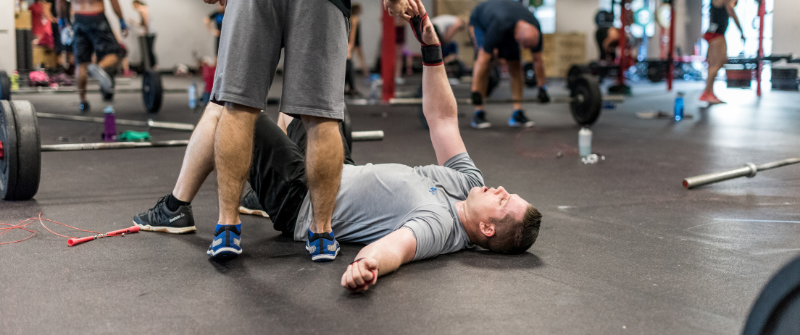Recovery is one of the most important parts of CrossFit training, but it’s definitely easy to overlook. When done right, CrossFit recovery helps build strength, improve endurance, and prevent injuries that could set you back.
Still, many athletes skip over the basics of how to recover properly from CrossFit workouts. This article covers the best recovery methods for CrossFit to help you get the most out of your training, both in and out of the gym.
Optimizing Post-Workout Nutrition
Optimizing nutrition after a workout is one of the best recovery methods for CrossFit. To support CrossFit muscle recovery, focus on replenishing glycogen with quality carbohydrates and pairing them with protein for muscle repair.
Whey, casein, and plant-based proteins all work well when taken within an hour of training.
Proper hydration also plays a huge role in CrossFit training recovery, especially when electrolytes are lost through sweat.
Supplements like BCAAs, creatine, and omega-3s can also support post-workout recovery for CrossFit by reducing inflammation. Pay attention to your nutrition and stay consistent with your workouts to aid your CrossFit recovery.
Prioritizing Sleep for Recovery
Sleep supports muscle repair, hormone regulation, and daily performance, but it’s often neglected. For CrossFit training recovery to be effective, most athletes need between seven and nine hours of quality sleep each night.
Muscle recovery slows down without enough rest, and progress becomes harder to maintain. To help improve sleep, limit screen time before bed, stick to a regular schedule, and use simple relaxation techniques like meditation or breathwork.
Remember that proper rest and recovery start at night, making sleep one of CrossFit’s best recovery methods.
Also Read: How to Become a Great CrossFit Coach
Active Recovery Techniques
Active muscle recovery keeps the body moving without adding extra strain. Walking, swimming, cycling, and other low-intensity workouts help with circulation and reduce soreness.
Mobility drills, such as foam rolling, resistance band stretching, or trigger point work, can improve range of motion. Yoga and simple breathing exercises also support CrossFit rest and recovery by easing tension and calming the nervous system.
Managing Muscle Soreness and Fatigue
Muscle soreness and fatigue are just part of the process with CrossFit, but how you manage them shapes your results. Cold therapy, like ice baths or cryotherapy, helps reduce inflammation and allows muscles to recover more efficiently.
Heat therapy has a different benefit: it promotes relaxation and helps ease tightness. Sauna sessions and warm baths are two effective ways to incorporate it into your CrossFit recovery routine.
Compression gear improves circulation, which helps reduce swelling and speed up CrossFit muscle recovery.
Massage and soft tissue work go further, breaking up tension and supporting mobility. Try blending these methods into your routine and notice the difference in how your body bounces back between each workout.
Structuring Rest Days Effectively
People often view rest as a break from progress, but it’s actually what allows progress to happen. Rest days are necessary to any training recovery plan as they give your body time to rebuild, support CrossFit muscle recovery, and help prevent burnout.
Some days may call for complete rest, while others might include light activity, but both play a role in CrossFit rest and recovery. Ignoring rest could result in signs of overtraining, like low energy, mood changes, or performance dips.
Managing Stress and Recovery Mindset
Your mental health, especially how you handle stress directly influences how well you recover. This is because mental strain takes a toll on the body and often interferes with CrossFit muscle recovery.
Practices like mindfulness, meditation, and journaling help support CrossFit training recovery by lowering stress levels and improving sleep.
Social recovery also matters, so spend time with the CrossFit community to boost motivation and cultivate a healthier mindset. Remember, managing stress is just as important as physical rest when it comes to workout recovery.
Also Read: What Are the 10 Components of CrossFit Physical Fitness?
Injury Prevention and Longevity
Smart training habits pay off more than training hard when it comes to CrossFit recovery. While many athletes try to rush through warm-ups and cooldowns, this part of the workout primes your muscles and reduces injury risk.
Your body speaks volumes if you listen, telling you when to intensify your efforts and when to prioritize CrossFit rest and recovery instead. On top of that, proper technique matters more than pushing through reps at any cost.
Protecting your body through proper form and pacing makes post-workout recovery for CrossFit much more effective.
Tracking and Adjusting Recovery Strategies
Getting the most out of your CrossFit recovery starts with tuning into your body and paying attention to what it’s telling you. Wearable fitness trackers help with this by providing data on heart rate variability and recovery trends over time.
Keeping a recovery journal is another useful tool, allowing you to track sleep, soreness, and daily performance. Effective CrossFit recovery comes from paying attention to what works best for your body and making adjustments as you go.
Conclusion
CrossFit recovery works best when it’s built into your routine right from the start. Focusing on sleep, nutrition, mobility, stress, and pacing yourself to improve CrossFit muscle recovery and support long-term performance.
Always keep in mind that rest and recovery aren’t separate from training. It plays a direct role in driving progress. When you take a consistent approach, the best recovery methods for CrossFit become habits that support your workouts day after day.
For more guidance on how to recover from CrossFit workouts and support post-workout recovery for CrossFit, visit the CrossFit RRG blog here.

